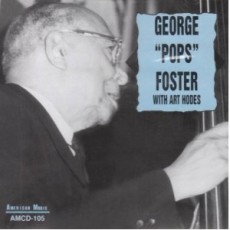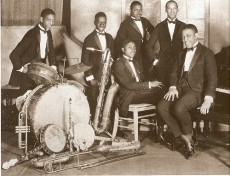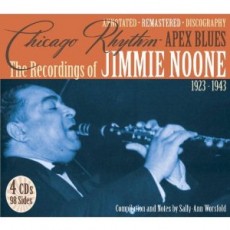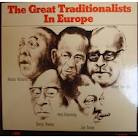
Daily Dose Of Jazz…
Pops Foster was born George Murphy Foster on May 19, 1892 on a plantation near McCall in Ascension Parish outside Baton Rouge, Louisiana. When his family moved to New Orleans he started playing cello at age 10 but then switched to string bass.
Foster was playing professionally by 1907 working with Kid Ory, Jack Carey, Armand Piron, King Oliver and other prominent hot bands of the era. In 1921 he moved to St. Louis and joined the Charlie Creath and Dewey Jackson bands, in which he would be active for much of the decade. He would rejoin Kid Ory in Los Angeles and acquire the nickname “Pops” because he was far older than any of the other players in the band.
By the end of the Roaring Twenties he was back in New York City playing in the bands of Luis Russell and Louis Armstrong till 1940. From that point he would gig with Sidney Bechet, Art Hodes and other various New York bands along with regular broadcasts on the national This Is Jazz radio program.
He toured widely during this period throughout Europe and the United States and was well loved in France. He would return to New Orleans and California regularly. Through the 50s and 60s he played with Jimmy Archey, Papa Celestin, Earl Hines and the New Orleans All-Stars. Bassist Pops Foster, who also played tuba and trumpet, passed away on October 29, 1969 in San Francisco, California. His autobiography was published two years later.
More Posts: bass

Daily Dose Of Jazz…
Charlie Irvis was born May 6, 1899 in New York City. He first played trombone professionally with Bubber Miley in his youth and then with blues singer Lucille Hegamin in the “Blue Flame Syncopators” from 1920 to 1921. Following this stint, Charlie played with Willie “The Lion” Smith and with Duke Ellington’s Washingtonians and later with his orchestra from 1924 to 1926. During the years 1923 to 1927 he also recorded occasionally with Clarence Williams.
Irvis, along with friends Miley and Tricky Sam Nanton contributed to the development of “jungle sounds” or “growl effects” in trombone playing. After leaving Ellington’s band, for the rest of the decade and into the early 1930s he recorded with Fats Waller, played with Charlie Johnson and Jelly Roll Morton. Some of his final recordings were in 1931 with Miley again, and shortly thereafter with Elmer Snowden.
After the early 1930s, Charlie Irvis, best known for his work with Duke Ellington’s band, stopped playing and passed away in New York City sometime around 1939 in obscurity. He is pictured 2nd from left in the photograph.
More Posts: trombone

Daily Dose Of Jazz…
Jimmie Noone or Jimmy Noone was born on April 23, 1895 in Cut Off, Louisiana and started playing guitar. By 15 he switched to the clarinet, moved to New Orleans, studied with Lorenzo Tio and thirteen year old Sidney Bechet.
1912 found Jimmie playing professionally with Freddie Keppard in Storyville and over the next five years he performed with Buddy Petit, Kid Ory, Papa Celestin, the Eagle Band, and the Young Olympia Band, before moving to Chicago, Illinois and joining the Original Creole Orchestra. The following year, he joined King Oliver’s Creole Jazz Band, then in 1920 reunited with Keppard in Doc Cook’s band, which he would remain and make early recordings for six years.
Noone started leading the band at Chicago’s Apex Club in 1926. This band, Jimmie Noone’s Apex Club Orchestra, included alto saxophonist and clarinetist Joe Poston and pianist Earl Hines. Signing with Brunswick on their Vocalion label her recorded prolifically from 1928 to 1935, then moved to Decca the following year followed with a year at Bluebird.
A move to New York City in 1935 produced a short-lived band and club with Wellman Braud and Noone returned to Chicago. He continued to play at various clubs until 1943, moved to Los Angeles, California, joined Kid Ory’s band, which was featured for a time on a radio program hosted by Orson Welles. After playing only a few broadcasts with the band, the lyrical and sophisticated clarinetist, who would influence later clarinet players such as Artie Shaw, Irving Fazola and Benny Goodman, died suddenly of a heart attack at 48, in Los Angeles, California on April 19, 1944.
More Posts: clarinet

Daily Dose Of Jazz…
Herb Flemming was born Nicolaiih El-Michelle of North African descent on April 5, 1898 in Butte, Montana. He studied music and played mellophone and euphonium before switching to trombone. During World War I he was a member of James Resse Europe’s 15th New York National Guard Band and then Europe’s 369th U.S. Infantry Band in France in 1917.
Post war Flemming studied at the Frank Damrosch Conservatory playing cello followed by study at the St. Cecilia Academy in Florence and the University of Rome. By 1921 he was playing with Fred Tunstall, recording with Johnny Dunn, then joining Sam Wooding and Bobby Lee’s band in Philadelphia. In the 1920s he joined Lew Leslie’s Blackbirds show, which toured London and Paris toward the end of the decade.
Herb formed his own band, the International Rhythm Aces, in Europe around 1930, while continuing to work with Wooding. They collaborated in Berlin, then found work accompanying Josephine Baker. He would go on to play in Buenos Aires, Paris, Shanghai, Calcutta and Ceylon. By the mid-thirties he would play in Sestto Carlin’s Society Orchestra in Italy and interpret for the 1936 Olympic Games in Germany.
In the late 30s Herb Fleming returned home playing with Earl Hines, Fats Waller, and Noble Sissle prior to a move to California and working for the Internal Revenue Service. In the Forties he freelanced around New York, worked with Red Allen, moved to Spain, recorded with Walter Bishop Jr. and Albert Nichols. Returning to New York City, vocalist and trombonist Herb Fleming passed shortly afterward on October 3, 1976.
More Posts: trombone

Daily Dose Of Jazz…
Alberta Hunter was born on April 1, 1895 in Memphis, Tennessee to Laura Peterson, a maid in a Memphis brothel and Charles Hunter, a Pullman porter who she never knew. She attended Grant Elementary School, off Auction Street, which she called Auction School, in Memphis. Having had a difficult childhood, and not happy with her new stepfather and family she left for Chicago, Illinois, around the age of 11, in the hopes of becoming a paid singer. She had heard that it paid 10 dollars a week but instead of finding a job as a singer she had to earn money by working at a boarding house that paid six dollars a week as well as room and board.
Hunter began her singing career in a bordello and soon moved to clubs that appealed to men, black and white alike. By 1914 she was receiving lessons from jazz pianist, Tony Jackson, who helped her to expand her repertoire and compose her own songs. Singing around Chicago, one of her first notable experiences as an artist was at the Panama Club where she honed her craft before a cabaret crowd. Her big break came when she was booked at Dreamland Cafe, singing with King Oliver and his band.
She first toured Europe in 1917, performing before adoring and respectful audiences in Paris and London. Her career as singer and songwriter flourished in the 1920s and 1930s, and she appeared in clubs and on stage in musicals in both New York and London. The songs she wrote include the critically acclaimed Downhearted Blues in 1922. She recorded several records with Perry Bradford from 1922 to 1927 as well as sessions on Black Swan, Paramount, Gennett, OKeh, Victor and Columbia. While still working for Paramount, she also recorded for Harmograph Records under the pseudonym May Alix.
Alberta eventually moved to New York City. She performed with Bricktop and recorded with Louis Armstrong and Sidney Bechet. She headed the U.S.O.’s first black show, performing in Casablanca, Korea and other theaters of war during World War II and after, until her mother’s death in 1957. It was at this point that she left music for a career in healthcare, working at Roosevelt Island’s Goldwater Memorial Hospital for 20 years. The hospital forced Hunter to retire because it believed she was 70 years old but was actually 82 years old. Deciding to return to singing, she had a regular engagement at a Greenwich Village club, becoming an attraction there until her passing away on October 17, 1984.
Her life was documented in Alberta Hunter: My Castle’s Rockin’, a 1988 TV movie, narrated by the pianist Billy Taylor, and in Cookin’ at the Cookery, a biographical musical by Marion J. Caffey, in which Ernestine Jackson portrays her. Vocalist and composer Alberta Hunter was inducted to the Blues Hall of Fame in 2011, the Memphis Music Hall of Fame in 2015 and her comeback album, Amtrak Blues, was honored by the Blues Hall of Fame in 2009.
More Posts: vocal






